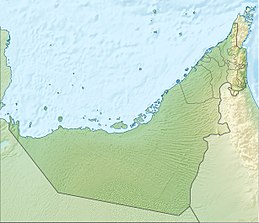Sir Bani Yas
| Native name: صير بنى ياس | |
|---|---|

Sir Bani Yas Island
|
|
| Geography | |
| Location | Persian Gulf |
| Coordinates | 24°20′N 52°36′E / 24.333°N 52.600°ECoordinates: 24°20′N 52°36′E / 24.333°N 52.600°E |
| Area | 87 km2 (34 sq mi) |
| Length | 17.5 km (10.87 mi) |
| Width | 9 km (5.6 mi) |
| Administration | |
| Emirate | Abu Dhabi |
Sir Bani Yas (Arabic: صير بنى ياس) is a natural island located 170 km (110 mi) southwest of Abu Dhabi, the capital of the United Arab Emirates. It lies 9 km (5.6 mi) offshore from Jebel Dhanna, which serves as a crossing point to other islands such as Dalma (island). Sir Bani Yas is 17.5 km (10.9 mi) from north to south and 9 km (5.6 mi) from east to west, making it the largest natural island in the United Arab Emirates. Located just off the shore of the Western region of Abu Dhabi, Sir Bani Yas island was originally home to Arabia's largest wildlife reserve. Spanning over 87 km2 (34 sq mi), the reserve was established in 1977 by Sheikh Zayed Bin Sultan Al Nahyan. Thanks to decades of conservation work and ecological investment, it is now home to thousands of large free-roaming animals and several million trees and plants. A bird sanctuary as well as a wildlife reserve, Sir Bani Yas showcases nature through activities such as adventure safaris, kayaking, mountain biking, archery, hiking and snorkeling.
The name Sir Bani Yas Island originates from the Bani Yas tribe, who first inhabited Abu Dhabi. Sir Bani Yas Island is the crest of a salt dome created millions of years ago by natural geological forces.
The first human settlers arrived several thousand years ago. Thirty-six archaeological sites have been discovered throughout Sir Bani Yas, each providing a distinct insight into the island's history. One of the oldest sites is the remains of a Nestorian Christian monastery which dates back to 600 AD. Each of these sites has now been carefully covered, to protect them until the time when they can be incorporated into the destination experience.
Sir Bani Yas Island was first mentioned in European literature around 1590, when the Venetian jeweller Gasparo Balbi listed "Sirbeniast" as an island around which pearls were often found. It was also described in some detail during the 1820s and 1850s by British naval officers who were surveying the lower Gulf waters.
In 1971 Sheikh Zayed became the first president of the United Arab Emirates, and chose this island as a retreat. In 1977, he passed a law prohibiting hunting on the island and started developing it as a wildlife preserve in his "Greening of the Desert" programme, which was designed to help make the deserts more suitable for human settlement and provide a haven for many of Arabia's endangered wildlife species. Several millions trees were planted and numerous animals species introduced to the island, including gazelle, oryx, llama, rhea, giraffe, and ostrich. Once the reserve was established, Sheikh Zayed wanted to share the results with the world; hence it was opened to weekend tourists. These tours soon became so popular that visits would often have to be booked over one year in advance.
...
Wikipedia

